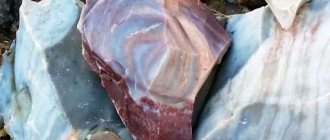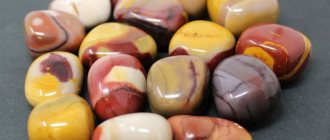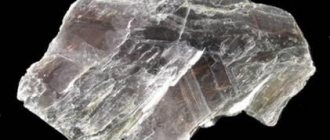Story
The fact that primitive man survived the confrontation with natural elements and predators is largely due to flint.
This pebble became the first tool for making fire; scrapers, drills, needles, and arrowheads were also made from it. Tribes leading a primitive way of life in the wilds of Africa or the Amazon still use them today.
Flint flint served as the “trigger” of firearms until the 19th century.
It is no coincidence that the name of the stone comes from the ancient Greek “kremnos”, which means “to burn”.
The millstones of hand and mechanical mills were also made of flint.
By hitting pebbles one against the other, you can create a spark. Modern children amuse themselves with them and tourists use them on occasion. They are part of a modern “survival kit”.
How to choose a stone and where to get it?
Natural silicas are most often mixtures of quartz, opal, and chalcedony.
The color of the stones varies from red-brown to gray-black. to select minerals from river and sea shores to infuse water .
The porous structure of the top layer absorbs environmental pollution. Flint mined from the depths of the earth has a purifying power. A reliable way to purchase a real mineral is to buy pharmacy products. The cost of a package weighing 150g is on average 250 rubles.
It is not worth buying minerals in markets or from private traders. An accidental purchase may not purify the water, but, on the contrary, fill it with bacteria and harmful microorganisms. Dark stones may be radioactive.
The debate about which stone is healthier, red-brown, gray, black, has been going on for a long time. In addition to silicon, the mineral contains additional elements of metals and other substances. The doctor can tell you about their effect on the body after examining the patient.
You can obtain purified water using special cartridges filled with silicon for activator jugs. But if you purchased real opal-chalcedony flint, then it is better to infuse the healing water yourself.
Description
Flint is an opaque rock, a type of quartz.
Color ranges from yellowish to black. Colors are determined by impurities (hematite, goethite, pyrite). Organic inclusions create black agglomerates.
Monochrome specimens are common; patterned or striped stones look exotic.
Typical flint is a fine-grained multicomponent formation of silica. Usually in limestone strata, it includes grains of quartz, chalcedony, and, less commonly, opal of microscopic dimensions. It is not uncommon to see zonal replacement of organic remains with stone. We are talking about corals and fossilized shells of extinct mollusks.
What does it look like?
Photo:
In appearance, flint can be confused with an ordinary cobblestone, but on the chip it is unevenly painted with multi-colored stripes.
Despite its hardness, the block with a matte sheen can be easily chipped with tools, and after striking dry fragments, sparks can be struck.
On opaque plates with a uniform structure and sharp edges, patterns of various colors are found.
Paleontologists suggest that sand or clay rock impregnated with gel-like silica is involved in the formation of flint.
In nature, deposits with stone veins look like rounded branches, threads of a spider's web.
Physico-chemical characteristics
To a chemist, the mineral flint is a silicate of sedimentary or volcanic origin. Its basic formula is simple, but such a variant is rare in nature. More often, the composition is complicated by impurities, of which the stone has plenty. They are “responsible” for the color and are indicated in the description.
| Rock type | Metamorphic rock |
| Mohs hardness of flint | 7 |
| Density | 2.6 g/cm3 |
| Color | The color is varied with a predominance of gray and dark gray tones. |
| Texture 2 | banded massive |
| Structure 2 | fine-grained |
| origin of name | from the Old Slavonic word “flint” - hard stone |
The strength and viscosity of agglomerates is a merit of the cryptocrystalline structure.
The peculiarity of flint is that it splits into thin plates with sharp, blade-like edges. It allows you to distinguish stone from imitation.
Flint stone: photo, properties and meaning (briefly)
The name of this stone should not be confused with silicon, a chemical element. Even though it is present in its chemical composition. The element silicon (or Silicium) is practically never found in nature in its pure form. But flint is a fairly common rock. According to geologists, almost a third of our earth’s crust is made up of it!
What is flint? This mineral formation is dark in color, quite hard and homogeneous. It is found in sedimentary deposits, most often in limestones. Each of us is familiar with flint since childhood. Upon impact, two such pebbles produce a beam of bright sparks and emit a characteristic odor. Remember, you probably conducted similar experiments in your childhood.
The word "flint" is masculine. And this is not only the name of the rock. This is also often used to describe a person who is stubborn, strong and unshakable in his convictions (“His character was as hard as flint”).
In the 21st century, flint is practically not used. But in the early stages of the development of our civilization, it was an indispensable assistant for humans.
Place of Birth
Flint is one of the most common rocks. There are deposits on all continents.
In addition to the island of Ruygen (near Germany), where the stone was first found, it is mined in Denmark, Poland, Kazakhstan, Belarus, Mongolia, Israel, and Great Britain.
In Russia, this is the north of the country: Karelia, Moscow region, Arkhangelsk, Belgorod, Tver regions.
Where is flint mined?
In nature, flint is found everywhere. You can find it without even setting such a goal for yourself. As for production in industrial quantities, in the Russian Federation it is found in the Tver, Moscow, and Belgorod regions. A large number of deposits have been mothballed.
Finding the mineral is not difficult; it is found almost everywhere.
The deposits on the territory of Southern Kazakhstan are interesting. In this region you can find flint in any color, including: white, gray, pink, lilac, yellow, brown.
Precious stones are mined in the Republic of Belarus. The oldest deposit in Europe is considered to be the island of Rügen in Germany on the border with Poland. It was once called Ruyana, and Slavic tribes lived there, and even earlier, the Saxons. Deposits are also being developed in the USA.
Areas of use
The very first use of flint in history was a device for making fire, scrapers, arrowheads, other tools and wars of Stone Age man.
Today, depending on the conditions, it is used by jewelers, stone-cutters, industrialists:
- The jewelry industry values chalcedony, jasper, and opals. These precious types of stone become jewelry inserts. There are also plenty of connoisseurs for black or spotted “pure” flint.
- Master stone-cutters cut candelabra, boxes, small plastic materials, and vases from colored materials. Black is used for exotic items such as “magic” pendants, stone knives or fire-making chairs.
- The rock is used to make slabs for countertops, fireplace, floor and panel slabs. This coating is valued for its minimal abrasion: flint is superior to granite in this parameter. For this reason it is in demand in public buildings, metro stations, and supermarkets.
The value of stone for other "practical" industries is also impressive. This is a raw material that increases the strength of non-ferrous and ferrous metallurgy products, an additive in concrete and other building mixtures.
Price
In the Russian segment of the Network there are jewelry, household items and collection material from various deposits of the planet (price/rub.):
- tumbling (1.5-3 cm; Poland) – 70-130;
- agate-shaped cabochon (20x30 mm, Moscow region) – 260-340;
- ball (53-58 mm, Madagascar) – 2,200 – 2,600;
- bracelet (jewelry alloy, Poland) – 2,340;
- black flint (cut, 12x12x3 mm, Moscow region) – 3,270.
The price of jewelry is affordable, since the frame is made of ordinary metals and alloys.
HOW TO MAINTAIN THE LEVEL AND CONTENT OF SILICON IN THE BODY?
Silicon water, prepared simply by the usual method of infusion on natural material, will be a very good help for everyone.
Collect smaller stones so that the surface of contact between silicon and water is as large as possible.
The water is constantly drained and used for enema. The bottom layer of water 3-4 cm is thrown away. Typically, infusion lasts 2-3 days. Silicon water can be infused at room temperature. Best served in an enamel container with a lid. For cooking and rinsing water for the enema, infuse water for 2 days. For treatment 5-7 days.
Each time after draining the water, rinse the bucket and silicon with running water.
Black stone is a practically non-consumable natural material. It will “work” without requiring replacement, rest and regeneration for you and your children.
Therapeutic effect
Flint is a traditional means of water purification. Even today they cover the bottom of wells and are sold for domestic use in homes with running water.
Along the way, the stone acts as an activator and structurer of water. That is, it releases its healing properties.
Healers claim that flint water heals all diseases and replaces soap.
It is recommended to drink water infused with black flints for fractures, bruises, and skin diseases. Or put pebbles on these places.
As a result, scratches, cuts, and other minor damage heal without a trace (that is, the formation of scars).
Even official medicine recognizes the usefulness of stone or water in destroying putrefactive microorganisms.
Which zodiac signs is it suitable for?
The astrological vector of the influence of flint has been well studied over the long history of mankind’s acquaintance with the durable mineral.
The mineral has different effects on all signs of the Zodiac:
- Aries frees the mind from negative thoughts and strengthens leadership qualities.
- Taurus protects against problems with the respiratory system.
- Gemini more honest, add sincerity, and endow it with eloquence.
- Cancer will be rewarded with success in business and will help cure stomach diseases.
- Leos will lose the hardships of life and mental pain, and will become more solid.
- Virgos realize their own potential and strengthen their nerves.
- Libras determination and help get rid of kidney ailments.
- Scorpios with a stone in their pocket will increase their influence on people.
- Sagittarius will be saved not only from prejudices, but also from liver diseases.
- Capricorn will add attention, sincerity, and ensure career growth.
- Aquarius will point out people devoted to him and protect him from manifestations of evil.
- for Pisces to wear a gem - it will increase their aggressiveness.
A stone marked by the influence of Mars is most suitable for signs belonging to the Fire element. This is Aries, Leo, Sagittarius.
Magic properties
The main magical property of flint is the concentration of human powers:
- A common attribute of magical rituals is a knife with a flint blade.
- It is recommended to buy a stone for a person who wants to increase willpower, become braver, more collected, and more purposeful.
Contemplation of a flint ball or pyramid calms the nerves and can attract a brilliant idea.
Raw flint is chosen as a home or office amulet. His magic neutralizes negative energy.









